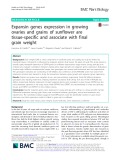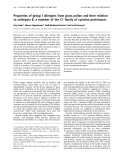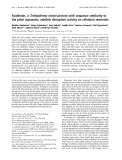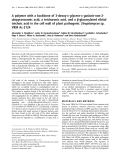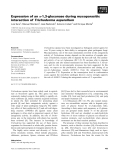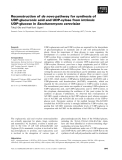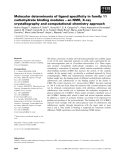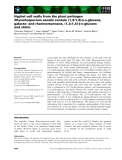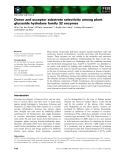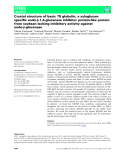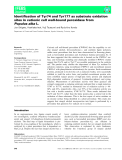
Plant cell wall
-
Grain weight (GW) is a key component of sunflower yield and quality, but may be limited by maternal tissues. Cell growth is influenced by expansin proteins that loosen the plant cell wall.
 14p
14p  vishikamaru2711
vishikamaru2711
 29-04-2020
29-04-2020
 11
11
 1
1
 Download
Download
-
Agrobacterium tumefaciens is a Gram-negative, phytopathogenic bacterium and is characterized by an unique mode of action on dicotyledonous plants: it is able to genetically modify the host, and because of this feature, it is used as a tool for transgenic plants. Many experiments have demonstrated that lipopolysaccharides (LPSs) play an important role for the disease development, as they are involved in the adhesion process of the bacterium on the plant cell wall.
 4p
4p  system191
system191
 01-06-2013
01-06-2013
 32
32
 4
4
 Download
Download
-
Expansins are a family of proteins that catalyze pHdependent long-term extension of isolated plant cell walls. They are divided into two groups, a and b, the latter consisting of the grass group I pollen allergens and their vegetative homologs. Expansins are suggested to mediate plant cell growth by interfering with either structural proteins or the polysaccharide network in the cell wall.
 10p
10p  research12
research12
 01-06-2013
01-06-2013
 28
28
 4
4
 Download
Download
-
Plant cell wall proteins called expansins are thought to disrupt hydrogen bonding between cell wall polysaccha-rides without hydrolyzing them. We describe here a novel gene with sequence similarity to plant expansins, isolated from the cellulolytic fungus Trichoderma reesei. The pro-tein named swollenin has an N-terminal fungal type cel-lulose binding domain connected by a linker region to the expansin-like domain.
 10p
10p  research12
research12
 23-04-2013
23-04-2013
 35
35
 4
4
 Download
Download
-
Structures of cell wall anionic polymers of the strainStrep-tomycessp. VKMAc-2124, a causative agent of potato scab, which is phylogenetically the closest to plant pathogenic speciesS. setoniiandS. caviscabies, were studied. The strain contains threeanionicglycopolymers, viz., a teichuronicacid with a disaccharide repeatingunitfi6)-a-D-Glcp-(1fi4)-b-D-ManpNAc3NAcA-(1fi,ab-glucosylated polymer of 3-deoxy-D-glycero-D-galacto-non-2-ulopyranosonic acid (Kdn), and ab-glucosylated 1,5-poly(ribitol phosphate). ...
 6p
6p  tumor12
tumor12
 22-04-2013
22-04-2013
 36
36
 4
4
 Download
Download
-
Tip growth is a specialized type of polar growth where new cell wall is deposited in a localized region of the cell, the growing tip. These cells show a characteristic zonation, with a high accumulationof secretory vesicles containing cell wall components at the tip, followed by an organelle-enriched zone.MsPG3is a Medicago sativapolygalacturonase gene isolated in our laboratory, specifically expressed during the interaction of this plant with its symbiotic partner Sinorhiz-obium melilotiand which might participate in tip growth processes during symbiosis....
 9p
9p  tumor12
tumor12
 20-04-2013
20-04-2013
 41
41
 3
3
 Download
Download
-
Trichodermaspecies have been investigated as biological control agents for over 70 years owing to their ability to antagonize plant pathogenic fungi. Mycoparasitism, one of the main mechanisms involved in the antagonistic activity ofTrichodermastrains, depends on the secretion of complex mix-tures of hydrolytic enzymes able to degrade the host cell wall. The antifun-gal activity of an a-1,3-glucanase (EC 3.2.1.59, enzymes able to degrade a-1,3-glucans and also named mutanases) has been described in T. harzia-num and its role in mycoparasitic processes has been suggested....
 0p
0p  awards
awards
 05-04-2013
05-04-2013
 43
43
 4
4
 Download
Download
-
UDP-d-glucuronic acid and UDP-d-xylose are required for the biosynthesis of glycosaminoglycan in mammals and of cell wall polysaccharides in plants. Given the importance of these glycans to some organisms, the development of a system for production of UDP-d-glucuronic acid and UDP-d-xylose from a common precursor could prove useful for a number of applications.
 13p
13p  inspiron33
inspiron33
 26-03-2013
26-03-2013
 67
67
 5
5
 Download
Download
-
The direct conversion of plant cell wall polysaccharides into soluble sugars is one of the most important reactions on earth, and is performed by cer-tain microorganisms such as Clostridium thermocellum(Ct). These organ-isms produce extracellular multi-subunit complexes (i.e. cellulosomes) comprising a consortium of enzymes, which contain noncatalytic carbohy-drate-binding modules (CBM) that increase the activity of the catalytic module.
 12p
12p  media19
media19
 06-03-2013
06-03-2013
 45
45
 4
4
 Download
Download
-
A procedure has been developed for the isolation of cell walls from the hyphae of the causal agent for barley leaf scald,Rhynchosporium secalis (Oudem) J.J. Davis. Based primarily on monosaccharide linkage analysis, but also on the limited use of linkage-specific glucan hydrolases and solvent fractionation, the walls consist predominantly of (1,3⁄1,6)-b-d-glucans
 12p
12p  vinaphone15
vinaphone15
 25-02-2013
25-02-2013
 36
36
 1
1
 Download
Download
-
Plant family 32 glycoside hydrolase enzymes include hydrolases (cell wall invertases, fructan exohydrolases, vacuolar invertases) and fructosyltrans-ferases. These enzymes are very similar at the molecular and structural levels but are functionally different. Understanding the basis of the func-tional diversity in this family is a challenging task.
 11p
11p  viettel02
viettel02
 20-02-2013
20-02-2013
 45
45
 2
2
 Download
Download
-
b-Linked glucans such as cellulose and xyloglucan are important compo-nents of the cell walls of most dicotyledonous plants. Theseb-linked glu-cans are constantly exposed to degradation by various endo-b-glucanases from pathogenic bacteria and fungi.
 11p
11p  cosis54
cosis54
 05-01-2013
05-01-2013
 50
50
 6
6
 Download
Download
-
Cationic cell wall-bound peroxidase (CWPO-C) has the capability to oxi-dize sinapyl alcohol, ferrocytochromec, and synthetic lignin polymers, unlike most peroxidases that have been characterized in flowering plants, such as horseradish peroxidase and Arabidopsis thalianaperoxidase A2.
 10p
10p  cosis54
cosis54
 08-12-2012
08-12-2012
 39
39
 3
3
 Download
Download
CHỦ ĐỀ BẠN MUỐN TÌM








